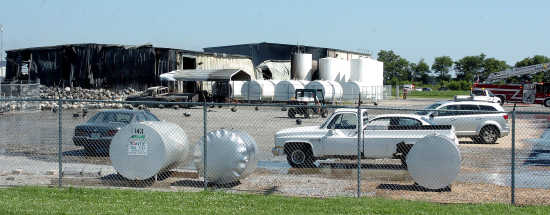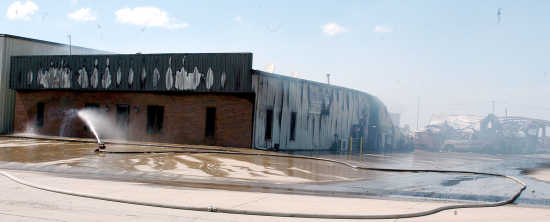WASHINGTON, DC
The National Transportation Safety Board recommended that
motorcoach interiors be designed with improved flammability requirements
as well as improved emergency exits, and that event data recorders be
installed on commercial trucks and motorcoaches. The recommendations
resulted from the investigation of the truck-motorcoach collision that
resulted in 10 fatalities in Orland, California on April 10, 2014.
In the crash, a 2007 Volvo truck-tractor,
operated by FedEx Freight, Inc. crossed a 58-foot-wide median, struck a
2013 Nissan Altima four-door passenger car, and then collided head-on
with a 2014 Setra motorcoach. Both the truck and the motorcoach drivers
were killed, along with eight motorcoach passengers. Thirty-seven
motorcoach passengers and two occupants of the passenger car were
injured.
Investigators were unable to determine why
the truck crossed the median, but they ruled out truck and motorcoach
driver experience, licensing and training, as well as alcohol and drug
use, mechanical factors, and weather as causes of the crash. Likewise,
the agency found no evidence that the driver was experiencing
distraction, fatigue, or that he intentionally crossed into opposing
traffic.
“The investigation brought to light the
difficulty of getting out of a burning motorcoach,” said NTSB Chairman
Hart. “It is unacceptable for anyone who survives a crash to perish in a
post-crash fire because the exits were too hard to find or too
difficult to use.”
The investigation revealed inadequacies in
the fire performance standards for commercial passenger vehicle
interiors, Federal Motor Vehicle Safety Standard (FMVSS) 302. The
flammability testing under FMVSS 302 involves a small-scale fire source,
such as those that might be caused by matches or cigarettes – which
differ drastically from the actual common causes of bus fires.
The Board also found that neither the
motorcoach driver who initiated the trip nor the relief driver gave a
safety briefing or played the prerecorded safety briefing that the
company had provided, and many passengers struggled to locate and open
the emergency exit windows. At least two passengers died because they
could not exit the motorcoach before succumbing to asphyxiation due to
inhaling smoke from the fire.
A pre-trip safety briefing or a video about
evacuation could have expedited the evacuation process and possibly
saved lives and mitigated injuries. The Board has also found that the
windows on the accident motorcoach, from which escaping passengers had
to jump, were more than seven feet off the ground – higher than the
wings of some airplanes – and did not have a mechanism to keep them
open.
The Board concluded that current standards lack adequate
requirements for emergency lighting and signage and reiterated several
longstanding previous recommendations for standards that that would
require independently powered lighting fixtures, use of photo
luminescent material to mark emergency exits, and windows that remain
open after being opened for emergency evacuations.
The Board also
concluded that having a secondary door for use as an emergency exit
would expedite evacuations and reduce the potential for injuries caused
by jumping from window exits.
Hart said that neither the truck-tractor nor
the motorcoach had event data recorders, which impeded the investigation
of the accident’s cause.
“With access to event data recorders, we
might have been able to determine why the truck crossed the median,
which could have enabled us to make recommendations to prevent it from
happening again,” Hart said. “Much of the reason that aviation is so
safe today is that we have required such recorders for decades so that
we can learn the lessons of accidents. But they are still not required
in commercial trucks or motorcoaches despite more than a decade of
recommendations by the NTSB.”
As a result of the investigation, the NTSB
issued safety recommendations regarding commercial passenger vehicles to
the National Highway Traffic Safety Administration and the Federal
Motor Carrier Safety Administration that address the fire performance
standards; pretrip safety briefings; improving vehicle design to
facilitate evacuations; requiring the development of minimum performance
standards for event data recorders in trucks and motorcoaches; and
requiring them to be installed in these vehicles.
The full report will be available on the NTSB website in several weeks.
////////////----------------/////////////
NATIONAL TRANSPORTATION SAFETY BOARD
Public Meeting of July 14, 2015
(Information subject to editing)
Truck-Tractor Double Trailer Median Crossover Collision With Motorcoach and Postcrash Fire on Interstate 5, Orland, California
April 10, 2014
This is a synopsis from the NTSB’s report and does not include the Board’s rationale for the conclusions, probable cause, and safety recommendations. NTSB staff is currently making final revisions to the report from which the attached conclusions and safety recommendations have been extracted. The final report and pertinent safety recommendation letters will be distributed to recommendation recipients as soon as possible. The attached information is subject to further review and editing.
Executive Summary
On April 10, 2014, about 5:40 p.m., a 2007 Volvo truck-tractor in combination with double trailers, operated by FedEx Freight, Inc., was traveling southbound in the right lane of Interstate 5 (I-5) in Orland, California. At the same time, a 2014 Setra motorcoach, operated by Silverado Stages, Inc., was traveling northbound on I-5 in the right lane. In the vicinity of milepost 26, the combination vehicle moved into the left lane, entered the 58-foot-wide center median, and traveled into the northbound traffic lanes of I-5.
The truck-tractor collided with a 2013 Nissan Altima four-door passenger car, which then rotated counterclockwise and departed the highway to the east. The truck-tractor continued moving south in the northbound lanes and collided with the front of the motorcoach, and both vehicles partially departed the highway to the east. A postcrash fire ensued. Both the truck and the motorcoach drivers died, along with eight motorcoach passengers. The remaining 37 motorcoach passengers received injuries of varying degree. The two occupants of the passenger car received minor injuries.
The crash investigation focused on the following safety issues:
• Lack of adequate fire performance standards for commercial passenger vehicle interiors: The NTSB considered several factors that might have contributed to the severity of the postcrash fire and affected the egress of motorcoach passengers. These factors included an inadequate Federal Motor Vehicle Safety Standard (FMVSS) 302, which specifies the burn resistance requirements for materials used in the occupant compartments of passenger vehicles, trucks, and buses. The standard is intended to reduce deaths and injuries caused by vehicle fires. However, FMVSS 302 flammability testing involves a small-scale fire source as a test method to represent fire originating in the passenger compartment from sources such as matches or
cigaretteswhich differs drastically from the common causes of bus fires, such as in-service ignition (engine fires, wheel well fires) or postcrash fuel-fed fires. Moreover, this standard is outdated and less discriminating than the flammability standards applied in other modes of transportation under US Department of Transportation safety oversight, such as aviation and rail.
• Pretrip safety briefings for commercial passenger vehicles: In evaluating the circumstances of this crash, the NTSB examined the activities of the motorcoach driver who picked up the students in Los Angeles and the driver who relieved him in Sacramento with regard to providing safety information. Our investigation revealed that neither driver played the prerecorded safety briefing that the company had provided. The passengers were not informed of the availability of seat belts on the newly manufactured motorcoach and were not wearing them at the time of the collision. Numerous passengers were injured. When the postcrash fire occurred, passengers reported being panicked and not knowing how to evacuate the bus because of the damaged and inoperable front loading door, the quickly spreading fire, the thick smoke, and the intense heat. The NTSB maintains that it is essential for motorcoach passengers to be informed of safety features and emergency evacuation procedures.
• Improvements in commercial passenger vehicle design to facilitate evacuation: Motorcoaches and buses must be designed to accommodate the rapid egress of all persons in an emergency situation. The windows on the accident motorcoach were more than 7 feet off the ground and did not have a mechanism to keep them open to facilitate safe evacuation. In addition, the lack of federal standards requiring motorcoaches to be equipped with reliable emergency lighting fixtures with a self-contained independent power source puts passengers in jeopardy. Federal safety standards lack adequate requirements for emergency lighting and interior luminescent and exterior retroreflective emergency signage in the event of a crash, fire, or other emergency. Although Federal safety standards permit a second door that can be used as an emergency exit, they do not require such.
• Event data recorder (EDR) survivability for crash reconstruction and safety improvements: The truck-tractor was equipped with an electronic control module (ECM) capable of recording certain vehicle-related data in the event of sudden deceleration or hard braking. The motorcoach was equipped with a common powertrain controller (CPC) capable of recording vehicle-related data, includingbut not limited tovehicle speed, engine speed, throttle usage, cruise control usage, brake pedal application, and clutch pedal application. However, as a result of the collision and postcrash fire, both the truck-tractor ECM and the motorcoach CPC were destroyed. Neither unit was a dedicated crash EDRwhich would likely have survived the forces and thermal conditions of the crash, and would have provided critical data on driver inputs and vehicle dynamics throughout the collision sequence. The NTSB maintains that incorporating longer pre-event recording times, learning as much as possible about a heavy vehicle driver’s precrash activities and vehicle control input, and gaining knowledge of the real-world crash dynamics of a collision
would yield crucial information for the development of safer highway vehicles. However, the National Highway Traffic Safety Administration (NHTSA) has failed to develop standards or require the use of EDRs for heavy vehicles, which include motorcoaches, school buses, or truck-tractor units such as the one involved in the Orland collision.
As a result of this crash investigation, the NTSB makes safety recommendations to the Federal Motor Carrier Safety Administration (FMCSA) and to NHTSA. We also supersede one recommendation to the FMCSA and reiterate seven recommendations to NHTSA.
Findings
1. None of the following were factors in the crash: (1) truck or motorcoach driver experience, licensing, or alcohol or drug use; (2) driver distraction or operational error; (3) motor carrier operations; (4) mechanical condition of either vehicle; or (5) weather.
2. The emergency response to the crash was timely and effective.
3. The truck driver did not depart the roadway to avoid another vehicle or a roadway obstruction.
4. The circumstances of the crash, such as the driver’s work and rest history and his complete lack of reaction to the roadway departure and crash event stimuli, are inconsistent with fatigue as a causal factor.
5. Based on the truck driver’s lack of braking or other appropriate reaction prior to or during the crash sequenceand witness accounts concerning the driver’s behavior and conditionhe was unresponsive due to an unknown cause, which prevented him from controlling his vehicle and led to the crash.
6. Based on the state of California’s median barrier application policies, which are more robust than national guidelines, the Orland crash location on Interstate 5 did not warrant a median barrier due to the average daily traffic and crash history.
7. The catastrophic rupture of the truck-tractor fuel tank released fuel that sprayed into the interior of the motorcoach, resulting in the fire and causing fatal and serious injuries to numerous motorcoach occupants.
8. Federal Motor Vehicle Safety Standard 302 does not adequately account for modern vehicle interior components or conditions experienced in real-world vehicle fires, nor does it include specific fire resistance material standards more appropriate for large commercial vehicles with increased passenger capacity.
9. The lack of a pretrip safety briefing led to confusion and panic during the motorcoach evacuation, as many passengers struggled to locate and open the emergency exit windows.
10. The quick-spreading fire and thick smoke prevented at least two passengers from extricating themselves from the motorcoach, resulting in their fatal injuries.
11. The lack of emergency lighting fixtures with self-contained independent power sources contributes to delays in the evacuation of motorcoach and bus passengers.
12. Federal Motor Vehicle Safety Standard 217 lacks adequate safety requirements for emergency lighting and interior luminescent and exterior retroreflective emergency signage in the event of a crash, fire, or other emergency.
13. The combination of the visibility issues due to smoke and a darkened interior, and concern over the risk of injury from exiting by way of the windows, negatively affected passengers trying to evacuate the motorcoach.
14. The evacuation of motorcoaches can be improved by the availability of a secondary door for emergency egress.
15. Having a secondary door for use as an emergency exit would expedite the evacuation process and reduce the need for passengers to jump from windows, thereby mitigating the potential for fatalities and injuries.
16. Due to a lack of standards and requirements for heavy vehicle event data recorders, crash data essential to better understanding collisions continue to go unrecorded, thus impeding improvements in highway safety.
Probable Cause
The National Transportation Safety Board (NTSB) determines that the probable cause of the Orland, California, crash was the inability of the FedEx Freight truck driver to maintain control of the vehicle due to his unresponsiveness for reasons that could not be established from available information. Contributing to the severity of some motorcoach occupant injuries were high impact forces; the release of combustible fluids, leading to a fast-spreading postcrash fire; difficulties in motorcoach egress; and lack of restraint use.
Recommendations
As a result of its investigation, the National Transportation Safety Board makes the following safety recommendations.
New Recommendations
To the National Highway Traffic Safety Administration:
1. Revise Federal Motor Vehicle Safety Standard 302 to adopt the more rigorous performance standards for interior flammability and smoke emissions characteristics already in use throughout the US Department of Transportation for commercial aviation and rail passenger transportation. (H-15-XX)
2. Require new motorcoach and bus designs to include a secondary door for use as an additional emergency exit. (H-15-XX)
To the Federal Motor Carrier Safety Administration:
3. Require all passenger motor carrier operators to (1) provide passengers with pretrip safety information that includes, at a minimum, a demonstration of the location of all exits, explains how to operate the exits in an emergency, and emphasizes the importance of wearing seat belts, if available; and (2) also place printed instructions in readily accessible locations for each passenger to help reinforce exit operation and seat belt usage. (H-15-XX) (Supersedes Safety Recommendation H-99-8)
4. Update your website guidance to include information on the mandated three-point restraints effective November 2016 for all new over-the-road buses and for other than over-the-road buses with a gross vehicle weight rating greater than 11,793 kilograms (26,000 pounds). (H-15-XX)
Previously Issued Recommendations Reiterated in This Report
The National Transportation Safety Board also reiterates the following safety recommendations:
To the National Highway Traffic Safety Administration:
Revise the Federal Motor Vehicle Safety Standard 217, “Bus Window Retention and Release,” to require that other than floor-level emergency exits can be easily opened and remain open during an emergency evacuation when a motorcoach is upright or at unusual attitudes. (H-99-9)
Develop and implement, in cooperation with other government agencies and industry, standards for on-board recording of bus crash data that address, at a minimum, parameters to be recorded, data sampling rates, duration of recording, interface configurations, data storage format, incorporation of fleet management tools, fluid immersion survivability, impact shock survivability, crush and penetration survivability, fire survivability, independent power supply, and ability to accommodate future requirements and technological advances. (H-99-54)
Revise the Federal Motor Vehicle Safety Standards to require that all motorcoaches be equipped with emergency lighting fixtures that are outfitted with a self-contained independent power source. (H-00-1)
Revise the Federal Motor Vehicle Safety Standards to require the use of interior luminescent or exterior retroreflective material or both to mark all emergency exits in all motorcoaches. (H-00-2)
Require that all buses above 10,000 pounds gross vehicle weight rating be equipped with on-board recording systems that: (1) record vehicle parameters, including, at minimum, lateral acceleration, longitudinal acceleration, vertical acceleration, heading, vehicle speed, engine speed, driver’s seat belt status, braking input, steering input, gear selection, turn signal status (left/right), brake light status (on/off), head/tail light status (on/off), passenger door status (open/closed), emergency door status (open/closed), hazard light status (on/off), brake system status (normal/warning), and flashing red light status (on/off; school buses only); (2) record status of additional seat belts, airbag deployment criteria, airbag deployment time, and airbag deployment energy; (3) record data at a sampling rate sufficient to define vehicle dynamics and be capable of preserving data in the event of a vehicle crash or an electrical power loss; and (4) are mounted to the bus body, not the chassis, to ensure recording of the necessary data to define bus body motion. (H-10-7)
Develop and implement minimum performance standards for event data recorders for trucks with gross vehicle weight ratings over 10,000 pounds that address, at a minimum, the following elements: data parameters to be recorded; data sampling rates; duration of recorded event; standardized or universal data imaging interface; data storage format; and device and data survivability for crush, impact, fluid exposure and immersion, and thermal exposure. The standards should also require that the event data recorder be capable of capturing and preserving data in the case of a power interruption or loss, and of accommodating future requirements and technological advances, such as flashable and/or reprogrammable operating system software and/or firmware updates. (H-10-14)
After establishing performance standards for event data recorders for trucks with gross vehicle weight ratings over 10,000 pounds, require that all such vehicles be equipped with event data recorders meeting the standards. (H-10-15)
Previously Issued Recommendation Reclassified in This Report
The NTSB reclassifies Safety Recommendation H-99-8 from its current classification of “OpenAcceptable Alternate Response” to “ClosedSuperseded” in section 2.6.2, “Safety Recommendations,” of this report (superseded by Safety Recommendation H-15-XX).
To the Federal Motor Carrier Safety Administration:
Require motorcoach operators to provide passengers with pre-trip safety information. (H-99-8)




















